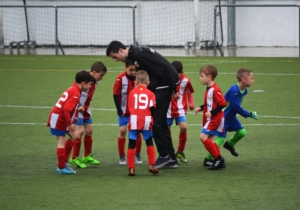Helping Your Child Navigate Anger
Anger is a normal part of growing up, but chronic uncontrolled anger in children can lead to emotional and physical health issues. Ephesians 4:26 says, “…in your anger do not sin,” which implies that it is okay to feel angry, but you should not let it control your behavior.
There are healthy and unhealthy ways that anger can be expressed, and as a parent, it is your responsibility to teach your kids how to express anger positively and constructively. But I understand that this can be extremely difficult, especially if you didn’t grow up with good role models or if this is an area where you’re still growing.
As a young child, I learned I could not express any negative emotions because my parents were not equipped to handle them. Whenever I didn’t comply or had anything to say that they didn’t agree with, they would lose control. They would yell and threaten me with physical punishment if I didn’t do what they asked.
 When I got older, I realized that my parents were repeating behaviors they had learned from their parents. After having my two daughters, I realized that if I didn’t change how I responded to my kids, I was destined to continue the same destructive cycle.
When I got older, I realized that my parents were repeating behaviors they had learned from their parents. After having my two daughters, I realized that if I didn’t change how I responded to my kids, I was destined to continue the same destructive cycle.
Managing anger is not a skill we are born with, and based on our environment, we can develop an unhealthy relationship with our emotions. As Christians, we are called to manage our emotions in a way that aligns with God’s will. We must learn how to do this and keep practicing in order to master it.
By mastering it, I mean that you can effectively manage anger by learning to control your reactions when you are triggered. You can learn to respond in a healthy way, rather than letting it control your behavior. Newport Beach Christian Counseling offers support and guidance to help you develop the tools needed to manage anger effectively.
The following are insights I have learned that can help you.
The Physiology of Anger
First, it’s important to have a basic understanding of how anger affects your mind, spirit, and body. Our brains are wired to react without thinking through the consequences of our actions. When we feel threatened our brain releases chemicals that give us a rush of energy. These chemicals prepare our body for action, but we can learn to switch this emotional response off by helping our brain find ways to gain control.
Once the switch is turned off, it will then allow you to decide how to react to the anger in a rational way and not on auto-pilot. When your kids push your buttons, your body gets wound up and prepared to fight, but the good news is that you can also wind your body back down to a more relaxed state.
Have you ever thought about how anger affects your spirit? Anger drains your inner peace and clouds your judgment. It hinders your connection to God and your loved ones, creating a sense of disharmony. It can leave you feeling depleted and even disconnected from yourself.
Proverbs 16:32 says, “Whoever is slow to anger is better than the mighty, and he who rules his spirit than he who takes a city.” In this verse, Solomon commends the person who can control their temper. Self-discipline that can put a lid on anger and control it is at a greater advantage than that of a soldier being able to defeat others in battle.
Your Child’s Temperament
 Temperament describes a child’s emotional and behavioral style. It’s their natural way of being and how they respond to others and the world around them. Temperament has a lot to do with how easily children can adapt to situations. Some children express anger more often than others. They may be more sensitive to how they are spoken to or looked at. If adults laugh at them or exacerbate them, they might withdraw, fight back, or cry.
Temperament describes a child’s emotional and behavioral style. It’s their natural way of being and how they respond to others and the world around them. Temperament has a lot to do with how easily children can adapt to situations. Some children express anger more often than others. They may be more sensitive to how they are spoken to or looked at. If adults laugh at them or exacerbate them, they might withdraw, fight back, or cry.
Some children have temperaments with high reactivity or low frustration tolerance. Children with high reactivity tend to respond strongly to environmental changes or perceived stressors, quickly escalating when things don’t go their way. Those with low frustration tolerance become easily frustrated when faced with challenges, leading to quick anger outbursts.
The more precisely you know your child and adapt your parenting style to meet their needs, the more quickly your child will learn to respond in healthy ways. Take advantage of those moments, as they are opportunities for you to help them regulate and grow emotionally.
The Roots Of Anger
Anger usually comes after your child has experienced some sort of pain. This pain can be physical or emotional. When that pain combines with certain thoughts or interpretations, your child may conclude that someone is trying to purposely hurt them.
Kids usually react with anger as a way to protect themselves or as a way to avoid feeling pain when they lack the emotional skills to identify and cope with complex feelings. When children lash out, they shift their focus away from themselves onto others.
 As parents, we can help our children by shifting our focus away from the external behavior to what might be lying underneath. By exploring the cause of the pain and providing comfort so that they can regulate their bodies, we can help them become emotionally mature.
As parents, we can help our children by shifting our focus away from the external behavior to what might be lying underneath. By exploring the cause of the pain and providing comfort so that they can regulate their bodies, we can help them become emotionally mature.
When my daughter was almost two years old, she went from 0-60 in less than three seconds. Her face would turn red then purple, and she would just stand there with her mouth wide open, but no sound would come out. I would often get anxious, not knowing what to do. At times it felt like she would pass out because it seemed like she couldn’t catch her breath.
I was at a loss as to what to do. Friends and family thought it was hysterical and would laugh, but this would only cause my daughter more pain and intensify her distress. I had no idea how to comfort her nor how to offer her support, so it went on for years. What started as a moment of dysregulation turned into many moments of my daughter suddenly bursting either into tears or anger when she was frustrated or upset.
Anger is energy
 When my daughters were young I had quite a temper. I would get angry when I cleaned the house and others weren’t helping. I would get angry when family members were on the couch watching TV and I felt that I never had time to rest. I would get angry when my kids had tantrums because it was such an inconvenience to my daily routine. I got angry a lot, and I was usually in a foul mood most of the time.
When my daughters were young I had quite a temper. I would get angry when I cleaned the house and others weren’t helping. I would get angry when family members were on the couch watching TV and I felt that I never had time to rest. I would get angry when my kids had tantrums because it was such an inconvenience to my daily routine. I got angry a lot, and I was usually in a foul mood most of the time.
I expected them to read my mind and know how tired I felt and want to naturally help me and ease my dissatisfaction with all the things I had to accomplish now that I was a parent. I expected them to make me happy by cooperating, listening, and complying.
When they didn’t, I was unhappy and it showed. Everyone walked on eggshells when I was around. I thought everyone was the problem except me. Luckily, I went on a personal journey and discovered that due to childhood trauma and other factors, I had developed an unhealthy relationship with my emotions.
Seeking Support To Grow Spiritually
Nobody changes on their own. If you want to grow emotionally and spiritually by dealing with past traumas that can be attributed to repressed anger or simply learn skills you were never taught to become a better parent, reach out for support at Newport Beach Christian Counseling . I believe that it’s never too late to make adjustments today that will greatly benefit you tomorrow. You get to decide the kind of legacy you want to hand down to your children.
“Mother and Son”, Courtesy of Kindel Media, Pexels.com, CC0 License; “Interruption”, Courtesy of $RDNE Stock Project, Pexels.com, CC0 License; “Cuties”, Courtesy of Bess Hamiti, Pexels.com, CC0 License; “Hugs”, Courtesy of Keira Burton, Pexels.com, CC0 License

 The fact that you’ll be moving is obvious enough, but what isn’t always obvious is why. Take the time to explain to your children, at an age-appropriate level, the reasons for the move, and then take time to listen to their concerns. Validate any concerns that they have and address these as honestly as you can. Give them room to express themselves, whether by talking, drawing, or writing.
The fact that you’ll be moving is obvious enough, but what isn’t always obvious is why. Take the time to explain to your children, at an age-appropriate level, the reasons for the move, and then take time to listen to their concerns. Validate any concerns that they have and address these as honestly as you can. Give them room to express themselves, whether by talking, drawing, or writing. Obsessions are repetitive, involuntary, fear-producing, thoughts that the child does not want to have but cannot stop thinking about or control, and that can have a paralyzing effect that prevents him or her from thinking about anything else.
Obsessions are repetitive, involuntary, fear-producing, thoughts that the child does not want to have but cannot stop thinking about or control, and that can have a paralyzing effect that prevents him or her from thinking about anything else. Treatment options
Treatment options
 A child who erupts in anger over a missed goal may be having social and emotional issues beyond the coach’s ability to navigate. However, by paying attention to a player’s response, the coach can bring the player’s behavior to light with a trusted school counselor or parent.
A child who erupts in anger over a missed goal may be having social and emotional issues beyond the coach’s ability to navigate. However, by paying attention to a player’s response, the coach can bring the player’s behavior to light with a trusted school counselor or parent.
 Simply being aware of these developmental aspects daily can help a teacher see beyond academics to the whole child. Teaching is stressful on any given day, but remembering that the children and adolescents they teach are still developing in every way fosters compassion and awareness.
Simply being aware of these developmental aspects daily can help a teacher see beyond academics to the whole child. Teaching is stressful on any given day, but remembering that the children and adolescents they teach are still developing in every way fosters compassion and awareness. Family is meant to be an institution for nurture, growth, joy, and flourishing. When we go through tragedy, or when we’re celebrating, our family is one space where we should feel encouraged and supported. The gap between what is and what ought to be is often a yawning chasm.
Family is meant to be an institution for nurture, growth, joy, and flourishing. When we go through tragedy, or when we’re celebrating, our family is one space where we should feel encouraged and supported. The gap between what is and what ought to be is often a yawning chasm. You don’t have to be a Christian to receive help from Christian family counseling, though the approach and emphases of the therapy will address spirituality as an important part of the whole. A Christian therapist will help you and your family identify behaviors that may be inconsistent with what God’s word says and that may be hindering your growth.
You don’t have to be a Christian to receive help from Christian family counseling, though the approach and emphases of the therapy will address spirituality as an important part of the whole. A Christian therapist will help you and your family identify behaviors that may be inconsistent with what God’s word says and that may be hindering your growth. Dealing with grief and loss.
Dealing with grief and loss. If you decide to seek help, you need to find a counselor that works for you and your family. The first obstacle to overcome, however, is that sometimes people hesitate to find help because of feelings of shame or a sense of failure. We all have different struggles, and when you reach your limit, the best thing you can do for your family is to take that courageous first step and ask for help.
If you decide to seek help, you need to find a counselor that works for you and your family. The first obstacle to overcome, however, is that sometimes people hesitate to find help because of feelings of shame or a sense of failure. We all have different struggles, and when you reach your limit, the best thing you can do for your family is to take that courageous first step and ask for help. The brokenness of life affects everyone, including children. But since children’s brains aren’t fully developed, sometimes we struggle to help them cope with difficulty or trauma. If you have a toolbox of techniques and activities for children, you can consider which one(s) might help an individual child in their situation.
The brokenness of life affects everyone, including children. But since children’s brains aren’t fully developed, sometimes we struggle to help them cope with difficulty or trauma. If you have a toolbox of techniques and activities for children, you can consider which one(s) might help an individual child in their situation. What is one thing you would like to teach someone else?
What is one thing you would like to teach someone else?
 Do you ever feel completely overwhelmed and exhausted, like you just want to check out of life?
Do you ever feel completely overwhelmed and exhausted, like you just want to check out of life? People may use the term “OCD” in an almost light-hearted manner to justify behaviors or rules which they themselves practice. But for anyone diagnosed with real Obsessive Compulsive Disorder (OCD), there is nothing light-hearted about their struggles. For them, the condition often brings distress and places limits on their every day lives to varying degrees.
People may use the term “OCD” in an almost light-hearted manner to justify behaviors or rules which they themselves practice. But for anyone diagnosed with real Obsessive Compulsive Disorder (OCD), there is nothing light-hearted about their struggles. For them, the condition often brings distress and places limits on their every day lives to varying degrees. The obsessions and compulsions are often connected, such as germophobia and washing one’s hands. Or, a student is so afraid of failing that he or she keeps on checking and checking his or her test answers even to the point of missing recess or lunch.
The obsessions and compulsions are often connected, such as germophobia and washing one’s hands. Or, a student is so afraid of failing that he or she keeps on checking and checking his or her test answers even to the point of missing recess or lunch.
 Teach your child to recognize their obsessions and compulsions. Knowledge is a power.
Teach your child to recognize their obsessions and compulsions. Knowledge is a power. By reading this article you’re taking the first step in what can be a journey of healing and hope. We’ll discuss different types of family counselors, how to select one who’s right for you, and how to budget for counseling. Take the time to consider each point in the selection process, and you’ll be equipped to make an informed decision.
By reading this article you’re taking the first step in what can be a journey of healing and hope. We’ll discuss different types of family counselors, how to select one who’s right for you, and how to budget for counseling. Take the time to consider each point in the selection process, and you’ll be equipped to make an informed decision. Behavior intervention applies to children who are struggling with problem behaviors, or to adults who are behaving inappropriately either in public or at home. In the family therapy setting, parents and the child will work with the counselor to identify unacceptable behaviors, set boundaries, and create rewards systems, along with other helpful skills.
Behavior intervention applies to children who are struggling with problem behaviors, or to adults who are behaving inappropriately either in public or at home. In the family therapy setting, parents and the child will work with the counselor to identify unacceptable behaviors, set boundaries, and create rewards systems, along with other helpful skills. Children going through puberty or experiencing life stress or mental health issues may struggle to have a good relationship with their parents. They may exhibit disrespect and dislike. Parents also deal with life stressors, mental health issues, and other factors that can make positive parenting difficult.
Children going through puberty or experiencing life stress or mental health issues may struggle to have a good relationship with their parents. They may exhibit disrespect and dislike. Parents also deal with life stressors, mental health issues, and other factors that can make positive parenting difficult. First, consider the value you place on therapy and the perspective that it can preventative medicine for your family relationships. Yes, therapy is expensive, but as counselors, we truly believe it’s worth it.
First, consider the value you place on therapy and the perspective that it can preventative medicine for your family relationships. Yes, therapy is expensive, but as counselors, we truly believe it’s worth it. In addition, children may be able to exert more control over their behavior in some kinds of circumstances rather than in others, particularly when emotions are running high. While parents find this understandably exasperating, it is normal.
In addition, children may be able to exert more control over their behavior in some kinds of circumstances rather than in others, particularly when emotions are running high. While parents find this understandably exasperating, it is normal. There may be various explanations for why a child steals. It may be that the act of stealing is exhilarating to a child, or perhaps because it enables them to somehow feel in control. It is important to question a child’s motivation to get to the bottom of the behavior.
There may be various explanations for why a child steals. It may be that the act of stealing is exhilarating to a child, or perhaps because it enables them to somehow feel in control. It is important to question a child’s motivation to get to the bottom of the behavior. The child may have an active imagination and find it hard to stay present, getting lost in their imaginings. If ADHD is the cause of the problem of ignoring others, it is possible for children to be taught ways of managing their difficulties with concentration.
The child may have an active imagination and find it hard to stay present, getting lost in their imaginings. If ADHD is the cause of the problem of ignoring others, it is possible for children to be taught ways of managing their difficulties with concentration. It is important to uncover the underlying reasons why a child feels the need to use substances – for example, is it as a means of coping? Or is it because of peer pressure from friends?
It is important to uncover the underlying reasons why a child feels the need to use substances – for example, is it as a means of coping? Or is it because of peer pressure from friends?